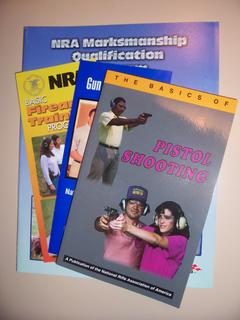What is Gun Handling?
A Google search for “gun handling” will return approximately 65,000 results. However, most of the search results are websites describing in some variation the three “fundamental NRA rules for safe gun handling” which are: 1. ALWAYS keep the gun pointed in a safe direction, 2. ALWAYS keep your finger off the trigger until ready to shoot and 3. ALWAYS keep the gun unloaded until ready to use.
These rules should be learned and made a part of your basic firearms practices, however they DO NOT address what in my opinion “gun handling” actually is.
“Gun Handling” is more than just the fundamental gun safety rules; it is everything you do with your firearm outside of the firing range. In other words, when you transport, wear, conceal or anticipate the use of your firearm you are engaging in “gun handling.” Think of “gun handling” as tactics with your firearm. If you are standing at point “A” and need to move to point “B” in order to avoid trouble, you do so in a “tactical” manner which means to MOVE and exhibit the proper gun handling skills while doing so. If you must draw your pistol from underneath a garment (movement), you do so while observing the basic gun safety rules.
When moving with a firearm you must observe all of the gun safety rules. You keep the gun pointed in a safe direction (Rule # 1) which I describe as the “Laser Safety Rule.” Also, you move while keeping your finger off the trigger until ready to shoot (Rule # 2) which I call the “Finger on the Frame Rule.” These rules must be followed and practiced ad nausium until they are a part of your very being.
Gun handling requires movement with purpose. If bad things are happening to you….maybe you should move to a new location. Running for the sake of running may not be the answer though. Seek out locations which will provide you with some tactical advantage. In the old western movies it was always the “high ground” that the good guys were seeking when responding to the bad guys. What you need to move to though is terrain which provides you with a tactical advantage. If you want to attract attention, then move to a lit or populated area. If you are trying to hide, then move into the shadows. If you are trying to call the police, then move to where you can get to your cell phone. The one “key” element in all of this is MOVEMENT. You must move in order to survive.
Gun handling is more than just basic Gun Safety coupled with Movement. It is the calculated movement with purpose with the proper gun-safety skills implemented.
For more information, view my website: Defensive Training Group
Semper Fidelis.
These rules should be learned and made a part of your basic firearms practices, however they DO NOT address what in my opinion “gun handling” actually is.
“Gun Handling” is more than just the fundamental gun safety rules; it is everything you do with your firearm outside of the firing range. In other words, when you transport, wear, conceal or anticipate the use of your firearm you are engaging in “gun handling.” Think of “gun handling” as tactics with your firearm. If you are standing at point “A” and need to move to point “B” in order to avoid trouble, you do so in a “tactical” manner which means to MOVE and exhibit the proper gun handling skills while doing so. If you must draw your pistol from underneath a garment (movement), you do so while observing the basic gun safety rules.
When moving with a firearm you must observe all of the gun safety rules. You keep the gun pointed in a safe direction (Rule # 1) which I describe as the “Laser Safety Rule.” Also, you move while keeping your finger off the trigger until ready to shoot (Rule # 2) which I call the “Finger on the Frame Rule.” These rules must be followed and practiced ad nausium until they are a part of your very being.
Gun handling requires movement with purpose. If bad things are happening to you….maybe you should move to a new location. Running for the sake of running may not be the answer though. Seek out locations which will provide you with some tactical advantage. In the old western movies it was always the “high ground” that the good guys were seeking when responding to the bad guys. What you need to move to though is terrain which provides you with a tactical advantage. If you want to attract attention, then move to a lit or populated area. If you are trying to hide, then move into the shadows. If you are trying to call the police, then move to where you can get to your cell phone. The one “key” element in all of this is MOVEMENT. You must move in order to survive.
Gun handling is more than just basic Gun Safety coupled with Movement. It is the calculated movement with purpose with the proper gun-safety skills implemented.
For more information, view my website: Defensive Training Group
Semper Fidelis.

